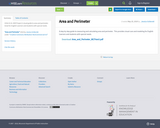
CESA #1 EL OER Project A visual guide to area and perimeter. Great for English Learners and students with special needs.
- Subject:
- Mathematics
- Material Type:
- Lesson
- Date Added:
- 05/25/2018

CESA #1 EL OER Project A visual guide to area and perimeter. Great for English Learners and students with special needs.
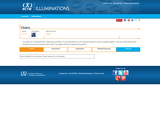
This Java applet activity allows students to explore the various situations described in "The Chairs Around the Table" lesson (cataloged separately). The user can select Exploration mode, in which the number of chairs needed for a particular arrangement of tables is displayed; or Guess, in which the user is able to construct an arrangement and then predict the number of chairs. There are two types of tables to choose from and two different table arrangements. Instructions and exploration question are provide.
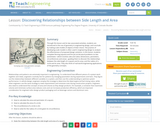
Through this lesson and its two associated activities, students are introduced to the use of geometry in engineering design, and conclude by making scale models of objects of their choice. The practice of developing scale models is often used in engineering design to analyze the effectiveness of proposed design solutions. In this lesson, students complete fencing (square) and fire pit (circle) word problems on two worksheets—which involves side and radius dimensions, perimeters, circumferences and areas—guiding them to discover the relationships between the side length of a square and its area, and the radius of a circle and its area. They also think of real-world engineering applications of the geometry concepts.

Unit Title: Dream Garden MeasurementsAuthor: Melissa WimmlerSchool: Discovery Charter School, Columbus School DistrictGrade Level: 2nd GradeContent Area(s): Math, Environmental ScienceContext: Our governance council is working on a school wide project to improve the lawn space in front of our school and create our dream garden. During this six-lesson unit the second-grade students estimated and accurately measured objects in the space and perimeter. The students calculated the area of the space and used square units to plan spaces and garden beds.
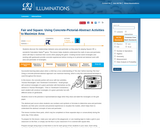
Through this four part lesson students develop an understanding of the relationship between area and perimeter. The lesson involves students making human rectangles, exploring geoboard connections, playing perimeter war, and playing Square Off from Calculation Nation. The lesson plan includes all data collection worksheets, games pieces, link to Calculation Nation, extension and assessment ideas.

Students develop and solidify their understanding of the concept of "perimeter" as they engage in a portion of the civil engineering task of land surveying. Specifically, they measure and calculate the perimeter of a fenced in area of "farmland," and see that this length is equivalent to the minimum required length of a fence to enclose it. Doing this for variously shaped areas confirms that the perimeter is the minimal length of fence required to enclose those shapes. Then students use the technology of a LEGO MINDSTORMS(TM) NXT robot to automate this task. After measuring the perimeter (and thus required fence length) of the "farmland," students see the NXT robot travel around this length, just as a surveyor might travel around an area during the course of surveying land or measuring for fence materials. While practicing their problem solving and measurement skills, students learn and reinforce their scientific and geometric vocabulary.
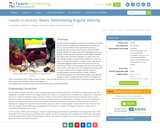
Students work as engineers and learn to conduct controlled experiments by changing one experimental variable at a time to study its effect on the experiment outcome. Specifically, they conduct experiments to determine the angular velocity for a gear train with varying gear ratios and lengths. Student groups assemble LEGO MINDSTORMS(TM) NXT robots with variously sized gears in a gear train and then design programs using the NXT software to cause the motor to rotate all the gears in the gear train. They use the LEGO data logging program and light sensors to set up experiments. They run the program with the motor and the light sensor at the same time and analyze the resulting plot in order to determine the angular velocity using the provided physics-based equations. Finally, students manipulate the gear train with different gears and different lengths in order to analyze all these factors and figure out which manipulation has a higher angular velocity. They use the equations for circumference of a circle and angular velocity; and convert units between radians and degrees.

This 40-day final module of the year offers students intensive practice with word problems, as well as hands-on investigation experiences with geometry and perimeter. The module begins with solving one- and two-step word problems based on a variety of topics studied throughout the year, using all four operations. Next students explore geometry. Students tessellate to bridge geometry experience with the study of perimeter. Line plots, familiar from Module 6, help students draw conclusions about perimeter and area measurements. Students solve word problems involving area and perimeter using all four operations. The module concludes with a set of engaging lessons that briefly review the fundamental Grade 3 concepts of fractions, multiplication, and division.
Find the rest of the EngageNY Mathematics resources at https://archive.org/details/engageny-mathematics.
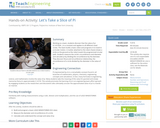
Working as a team, students discover that the value of pi (3.1415926...) is a constant and applies to all different sized circles. The team builds a basic robot and programs it to travel in a circular motion. A marker attached to the robot chassis draws a circle on the ground as the robot travels the programmed circular path. Students measure the circle's circumference and diameter and calculate pi by dividing the circumference by the diameter. They discover the pi and circumference relationship; the circumference of a circle divided by the diameter is the value of pi.

(Nota: Esta es una traducción de un recurso educativo abierto creado por el Departamento de Educación del Estado de Nueva York (NYSED) como parte del proyecto "EngageNY" en 2013. Aunque el recurso real fue traducido por personas, la siguiente descripción se tradujo del inglés original usando Google Translate para ayudar a los usuarios potenciales a decidir si se adapta a sus necesidades y puede contener errores gramaticales o lingüísticos. La descripción original en inglés también se proporciona a continuación.)
Este módulo final del año de 40 días ofrece a los estudiantes una práctica intensiva con problemas de palabras, así como experiencias prácticas de investigación con geometría y perímetro. El módulo comienza con la resolución de problemas de palabras de uno y dos pasos basados en una variedad de temas estudiados durante todo el año, utilizando las cuatro operaciones. A continuación, los estudiantes exploran la geometría. Estudiantes Tessellate para la experiencia de la geometría de puente con el estudio del perímetro. Las parcelas de línea, familiares del Módulo 6, ayudan a los estudiantes a sacar conclusiones sobre las mediciones de perímetro y área. Los estudiantes resuelven problemas de palabras que involucran área y perímetro utilizando las cuatro operaciones. El módulo concluye con un conjunto de lecciones atractivas que revisan brevemente los conceptos fundamentales de grado 3 de fracciones, multiplicación y división.
Encuentre el resto de los recursos matemáticos de Engageny en https://archive.org/details/engageny-mathematics.
English Description:
This 40-day final module of the year offers students intensive practice with word problems, as well as hands-on investigation experiences with geometry and perimeter. The module begins with solving one- and two-step word problems based on a variety of topics studied throughout the year, using all four operations. Next students explore geometry. Students tessellate to bridge geometry experience with the study of perimeter. Line plots, familiar from Module 6, help students draw conclusions about perimeter and area measurements. Students solve word problems involving area and perimeter using all four operations. The module concludes with a set of engaging lessons that briefly review the fundamental Grade 3 concepts of fractions, multiplication, and division.
Find the rest of the EngageNY Mathematics resources at https://archive.org/details/engageny-mathematics.
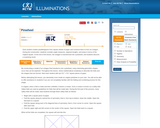
"Each student creates parallelograms from square sheets of paper and connects them to form an octagon. During the construction, students consider angle measures, segment lengths, and areas in terms of the original square" (from NCTM's Illuminations).
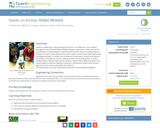
Students solidify their understanding of the terms "circumference" and "rotation" through the use of LEGO MINDSTORMS(TM) NXT robotics components. They measure the circumference of robot wheels to determine how far the robot can travel during one rotation of an NXT motor. They sharpen their metric system measurement skills by precisely recording the length of a wheel's circumference in centimeters, as well as fractions of centimeters. Through this activity, students practice brainstorming ways to solve a problem when presented with a given scenario, improve their ability to measure and record lengths to different degrees of precision, and become familiar with common geometric terms (such as perimeter and rotation).
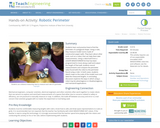
Students learn and practice how to find the perimeter of a polygonal shape. Using a ruler, they measure model rooms made of construction paper walls. They learn about other tools, such as a robot, that can help them take measurements. Using a robot built from a LEGO® MINDSTORMS® NXT kit that has been programmed to move along a wall and output the length of that wall, students record measurements and compare the perimeter value found with the robot to the perimeter found using a ruler. In both cases, students sketch maps to the scale of the model room and label the measured lengths. A concluding discussion explores the ways in which using a robot may be advantageous or disadvantageous, and real-world applications.
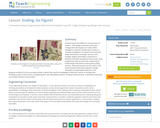
Students learn how different characteristics of shapes—side lengths, perimeter and area—change when the shapes are scaled, either enlarged or reduced. Student pairs conduct a “scaling investigation” to measure and calculate shape dimensions (rectangle, quarter circle, triangle; lengths, perimeters, areas) from a bedroom floorplan provided at three scales. They analyze their data to notice the mathematical relationships that hold true during the scaling process. They see how this can be useful in real-world situations like when engineers design wearable or implantable biosensors. This prepares students for the associated activity in which they use this knowledge to help them reduce or enlarge their drawings as part of the process of designing their own wearables products. Pre/post-activity quizzes, a worksheet and wrap-up concepts handout are provided.
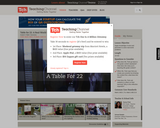
In this lesson, students deepen their understanding of the measurement of plane and solid shapes and use this understanding to solve problems. Students also identify and describe the properties of two-dimensional figures. Students are challenged to set a table for 22 using one unit lengths of paper (each unit length represents one student sitting at the table). They are asked to pretend that they all want to sit together for a dinner, and the table has to be rectangular. They must figure out what the table will look like if it must be rectangular and if everybody must sit at the table. They must determine what's the biggest table going to look like where everybody sits, and what's the smallest table going to look like where everybody sits. Students work to conceptually figure out relationships between perimeter and area in a creative and interactive way. They brainstorm ideas in groups, discuss as a class to determine the best options, and then physically set the two tables using strips of paper that represent "one unit" in length per person.
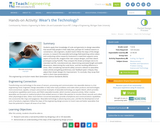
Students apply their knowledge of scale and geometry to design wearables that would help people in their daily lives, perhaps for medical reasons or convenience. Like engineers, student teams follow the steps of the design process, to research the wearable technology field (watching online videos and conducting online research), brainstorm a need that supports some aspect of human life, imagine their own unique designs, and then sketch prototypes (using Paint®). They compare the drawn prototype size to its intended real-life, manufactured size, determining estimated length and width dimensions, determining the scale factor, and the resulting difference in areas. After considering real-world safety concerns relevant to wearables (news article) and getting preliminary user feedback (peer critique), they adjust their drawn designs for improvement. To conclude, they recap their work in short class presentations.